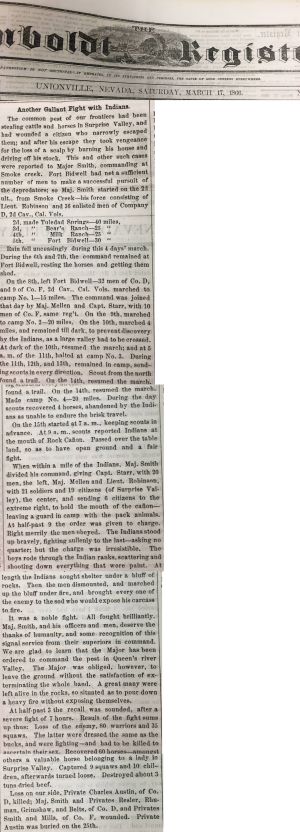Smoke Creek Band
Smoke Creek Sam's Indigenous name was Chief Saaba.[1] In 1860, Chief Saaba was for war, which resulted in the Paiute War.[2][3]
Sarah Winnemucca wrote that Omer C. Stewart suggested that the Smoke Creek band killed Demming. Sarah Winnemucca wrote that "Winnemucca exercised no authority beyond his relationship to the headman, reputedly a brother-in-law. Settlers drew no such distinctions. To them, Paiutes were Paiutes, and Winnemucca was responsible for all of them."
Captain Weatherlow also felt that the Smoke Creek Band were independent:
- "In the month of June, 1856, I settled in Honey Lake valley. There were but two or three houses in the valley at that time. The Pah-Ute tribe of Indians occupied the valley in common with the whites. They were on the most friendly relations, visiting the houses of the whites and trading furs and game for such articles of clothing, etc., as they desired. They were unlike any other tribe that I had met in the country, inasmuch as they were never known to beg for food or clothing, nor did they at every opportunity pilfer and carry off articles from the whites. They were under the control and command of Winnemucca, the present war chief, and faithfully obeyed his commands. There was a band, however, which lived in or near Smoke Creek canon, and were under the control of a chief known as Smoke Creek Sam. They had drawn out from Winnemucca's band, and although they were still on friendly terms with Winnemucca's people, yet they were in a degree independent of his control. This band was also on the most friendly terms with the whites. In the year 1855 (should be 1856 or 1857), the settlers in Honey Lake valley made a treaty with Chief Winnemucca,"[4]
Note that there was another Smoke Creek Sam, which was a pseudonym for William V. Kingsbury who operated the Smoke Creek Station.
"Big Jim" was a member of the Smoke Creek Band who was killed in June 1860, it was thought that Big Jim had murdered Horace Adams in the Honey Lake Valley.[5][6][7]
The Smoke Creek Band was accused of stealing cattle, which led to the Battle of Mud Lake at Winnemucca Lake in March 1865.
A May, 1865 article states that Smoke Creek Sam was killed at the Battle of Mud Lake, but this seems unlikely according to later reports.[8] The article states that Smoke Creek Sam swung a rifle to break the arm of a sergeant and that the sergeant later died. However, Captain Wells makes no mention of this incident.
Smoke Creek Jim was killed on March 15, 1866. His banner was taken as a prize by Whites, the banner was said to have been used by Jim to communicate with his warriors.[9] One soldier by the name of Austin was killed and 81 Paiutes killed.[10] Bancroft states that the battle occurred at "Rock Cañon" and that 115 Paiutes were killed.[11] A March 17, 1866 Humboldt Register article states that the "Loss to the enemy, 80 warriors and 35 squaws. The latter were dressed the same as the bucks, and were fighting - and had to be killed to ascertain their sex."[12]
Fairfield has a number of anecdotes about Smoke Creek Sam, stating that Smoke Creek Sam was responsible for attacks on Whites and that Chief Winnemucca had little control over Smoke Creek Sam. Smoke Creek Sam was killed in 1866 at Guano Valley in far northern Washoe County (today, Guano Valley is in Oregon).[13] Fairfield writes that Smoke Creek Sam was killed in 1866.[14]
An 1881 article states that Sa-aba was chief of the Smoke Creek Indians and brother-in-law of Old Winnemucca. Sa-aba was purported to have been killed by a member of his tribe whom he was "proposing to 'Ho-do' or bewitch.[15]
An 1888 article describes a fight between two women, one of whom was backed by Smoke Creek Sam.[16]

References
- ↑ "Numa, a Northern Paíute History," 1976.
- ↑ "Sand In A Whirlwind," 30Th Anniversary Edition, Ferol Egan, 2016.
- ↑ "Paiute War," Wikipedia.
- ↑ Illustrated history of Plumas, Lassen & Sierra counties, with California from 1513 to 1850," Fariss & Smith, 1882, p. 379.
- ↑ "Letter from the Lander Expedition," Daily Alta California, Volume 12, Number 195, July 15, 1860.
- ↑ "Chase and Capture of an Indian Chief," Newspapers.com, Orleans Independent Standard (Irasburgh, Vermont), August 17, 1860, p. 2
- ↑ "Fairfield's Pioneer History of Lassen County, California," p. 224
- ↑ "A Relic," Gold Hill Daily News, May 17, 1865, p. 3
- ↑ "An Aboriginal Banner," The Sacramento Bee, p. 3, June 25, 1866.
- ↑ "The Indian Battle in Surprise Valley—Eighty-one Killed," Daily Alta California, Volume 18, Number 5851, 18 March 1866.
- ↑ "History of Nevada, Colorado, and Wyoming, 1540-1888," Hubert Howe Bancroft, pp. 220-221, 1890.
- ↑ "Another Gallant Fight with Indians," Humboldt Register, March 17, 1866.
- ↑ "Fairfield's Pioneer History of Lassen County, California," p. 393
- ↑ "Fairfield's Pioneer History of Lassen County, California," p. 393
- ↑ "Indians and their wars in Nevada," The Daily Appeal (Carson City, Nevada), February 13, 1881, p. 1.
- ↑ "Savage Amusement," The Silver State, Unionville, Nevada, March 2, 1888, page 3.